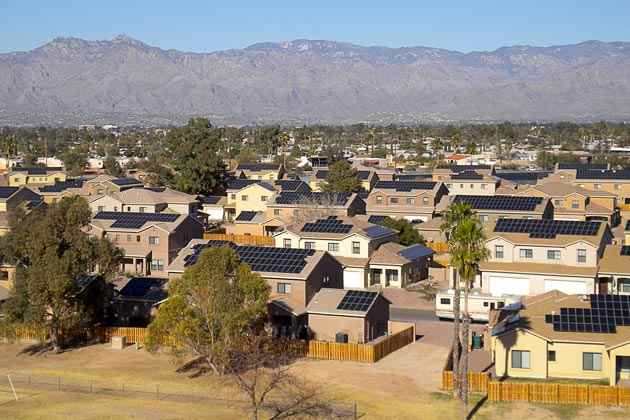forum
library
tutorial
contact

Tesla's Industrial-Grade
Solar Power Storage System
by Ashlee Vance
Bloomberg Businessweek, December 6, 2013
|
the film forum library tutorial contact |

|
Tesla's Industrial-Grade
by Ashlee Vance
|
 It's weird to see the big, red Tesla Motors "T" logo hanging from the side of a house or a building. But it's the real deal. The company's march from the automobile to the home, office, and factory has begun.
It's weird to see the big, red Tesla Motors "T" logo hanging from the side of a house or a building. But it's the real deal. The company's march from the automobile to the home, office, and factory has begun.
This week, SolarCity, which sells and installs solar panels for residential and commercial customers, began offering an industrial-grade power storage unit produced by Tesla (TSLA). The system mounts on a wall and looks something like a white mini-fridge with Tesla's distinctive logo in the upper left corner. It contains hundreds of the same lithium-ion batteries that Tesla's Model S sedan needs to run and, in fact, has about one-eighth of the juice found in Tesla's top-of-the-line battery pack. "If you go to the end of the manufacturing line at the Tesla factory where they put the battery pack on, you will see these storage systems being assembled," says Pete Rive, the co-founder and chief technology officer at Tesla.
The purpose of the storage system is twofold. It lets solar customers shift off the grid during times when energy companies charge their highest rates, and it provides a backup system during power outages. SolarCity has been offering these systems to consumers on a limited basis -- a few hundred customers so far -- and, as of this week, began selling it to commercial customers as well. Customers do not have to pay upfront for the hardware but will need, instead, to commit to a 10-year service agreement with monthly payments.
The battery pack would cost about $15,000 without financing. "Our long run goal is to include a storage system with every solar system we sell," says Rive.
Utility companies typically tack on so-called demand charges during times of intense use. SolarCity uses its own DemandLogic software to control the functions of the storage unit and weigh usage vs. rates. "Our software figures all this out and says, 'We will give you some juice right now, so you don't have to pay the demand charge,'" Rive says.
At home, Rive has experimented with disconnecting from the grid for a couple days at a time and relying on the storage system. "It has enough power for all the critical loads," he says. "You can bake a pizza while running your washer and drier." (Critical pizza. Check.)
The association between SolarCity and Tesla is natural fit. Elon Musk, the CEO of Tesla, serves as SolarCity's chairman and, during a road trip to Burning Man, helped come up with the idea for the company. He's also the cousin of Peter Rive and his brother, Lyndon Rive, who is SolarCity's CEO. During a recent visit to the company's headquarters in San Mateo, Calif., about 10 Tesla Model S all-electric sedans were in the parking lot.
At the most basic level, SolarCity looks like a solar panel installer. If, however, you dig a bit deeper, the company acts a lot more like a utility. It's the leader in solar installations and has created a network of capacity that now is complemented by these storage systems.
The energy companies have taken notice of SolarCity's growing ambitions. The company has been dragged into fights over the rebates people receive in some states for going solar. And politicians such as Jeff Sessions, the junior Republican senator from Alabama, have started offensives against the company, which will leave you shocked by this last sentence. Southern Co. (SO), a utility, is Session's largest donor.
learn more on topics covered in the film
see the video
read the script
learn the songs
discussion forum
